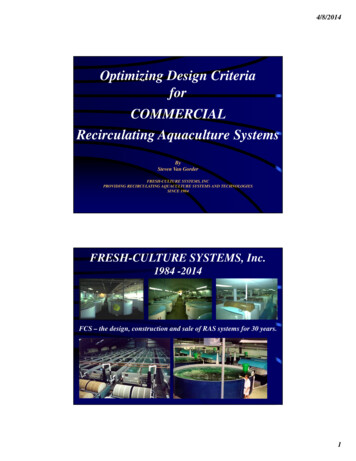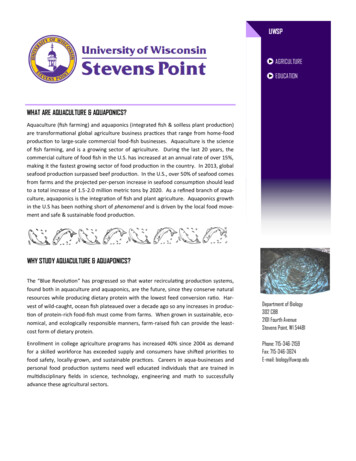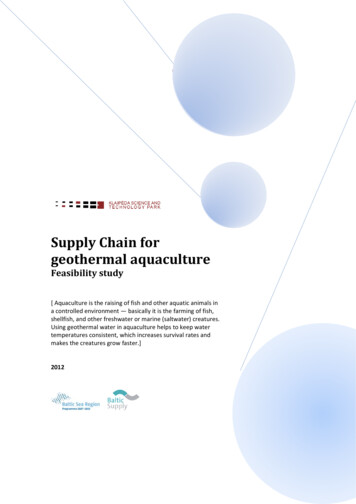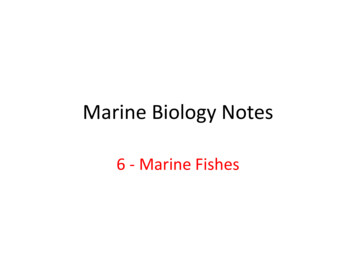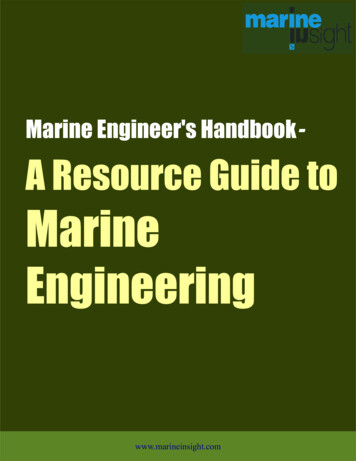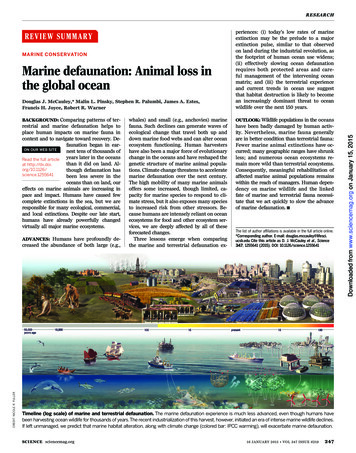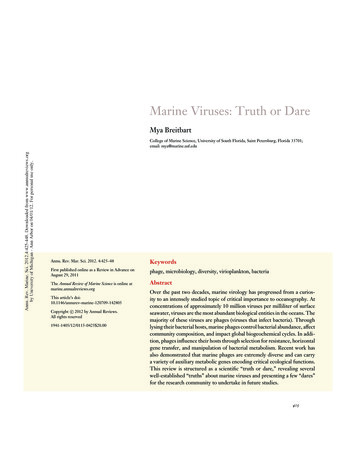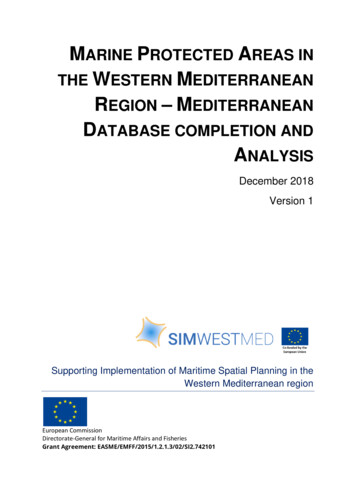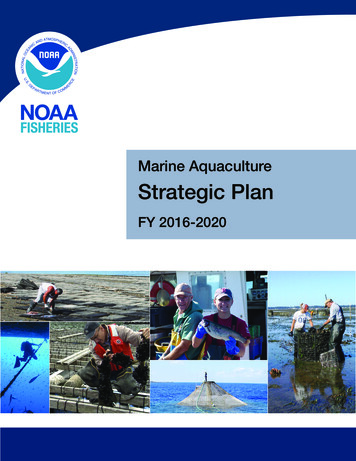
Transcription
Marine AquacultureStrategic PlanFY 2016-2020
Aquaculture provides valuable resources to people here in the United Statesand globally, and it will continue to grow well into the future. Together, weneed to develop a strategy to increase production in U.S. waters and increasepublic awareness of its importance to our sustainable seafood portfolio.Dr. Kathryn SullivanNOAA AdministratorSeaweb Seafood SummitFebruary 2015
Marine AquacultureStrategic PlanFY 2016-2020U.S. DEPARTMENT OF COMMERCENational Oceanic and Atmospheric AdministrationNational Marine Fisheries ServiceOffice of Aquaculture
ContentsPreface iiiSetting the Stage: Opportunities and Challenges2Vision and Mission 6Evaluating Our Impact8Goal 1: Regulatory Efficiency 10Goal 2: Tools for Sustainable Management12Goal 3: Technology Development and Transfer14Goal 4: Informed Public16Cross-Cutting Strategies18Deliverables 19References 22Appendix 1 - Program OverviewA1Appendix 2 - NOAA Aquaculture Funding HistoryA6
PrefaceMarine aquaculture enhances coastal resiliency, creates jobs, improves food security and human nutrition and is avaluable tool to help rebuild some protected species and habitats. Limits to wild fisheries, environmental changes,the nutritional benefits of seafood, and trends in global seafood markets underscore the need to increase U.S. marineaquaculture production and to selectively use aquaculture to help restore species and habitats.We have made significant progress in achieving our aquaculture mission since the adoption of our last strategic plan,the 2007 NOAA 10-Year Plan for Marine Aquaculture. With the support of our partners, NOAA has helped improvethe federal regulatory process for aquaculture, developed key products that serve the scientific needs of managementand industry, and now lists aquaculture as an agency priority. These efforts helped spark recent growth in U.S. marineaquaculture production.In this 5-year Strategic Plan, we take a fresh look at our priorities and address the regulatory, scientific, technical,communications, and organizational needs to advance U.S. marine aquaculture. This Plan will help ensure that NOAAis focused on critical aquaculture priorities to ensure an efficient and strategic use of limited resources.This Plan is intended to guide strategic actions within NOAA Fisheries but incorporates key activities undertaken byour NOAA partners at the National Ocean Service (NOS) and the Office of Oceanic and Atmospheric Research (OAR).While cognizant of limited resources, this Plan aspires to drive results and to help us reach our full potential.The Office of Aquaculture developed this Plan over several months through a collaborative process that included inputfrom the entire NOAA aquaculture team and other NOAA Fisheries offices and science centers. We sought review andinput from our stakeholders through a public comment period, including the Marine Fisheries Advisory Committee(MAFAC) Aquaculture Task Force. We have incorporated this valuable feedback to ensure this Plan reflects the needs ofour stakeholders.It took teamwork and advice from scientists, producers, nongovernmental organizations, and government agencies toproduce this Plan, and it will take the same to fulfill the challenging mission that we have laid out. By working together,we can ensure that U.S. marine aquaculture grows to provide significant environmental, social, and economic benefits tothe American public.Dr. Michael RubinoDirectorOffice of AquacultureU.S. Department of Commerce National Oceanic and Atmospheric Administration National Marine Fisheries Service iii
Setting the Stage: Opportunities andChallengesAquaculture in a global contextThe global human population is rising, but the global abundanceof wild fish is not. Wild fish harvests have been flat for the past 30years. Seafood plays an important role in global food supply andsecurity. About 3 billion people rely on seafood as one of theirprimary sources of animal protein. Ensuring that seafood supplycan keep up with increased demand from population growth andshifting demographics is vitally important.According to the United Nations Food and AgricultureOrganization (FAO), “with capture fisheries productionstagnating, major increases in fish food production are forecast tocome from aquaculture .[A]n additional 27 million metric tonsof production will be needed to maintain the present level of percapita consumption in 2030” (FAO 2012). This increased demandis driven in part by population growth but also by emergingmiddle classes in China, India, and Brazil, and accompanyingshifts in food preferences toward seafood.The FAO estimates that, globally, 29 percent of stocks are fishedat biologically unsustainable levels. Some great efforts havebeen made to address the overfishing problem, and incrementalprogress has been made at a global scale. But even with suchimprovements, wild capture fisheries will not meet the demandfor seafood.Aquaculture is well placed to help fulfill the demand. In manyparts of the world, aquaculture has already helped improvenutrition and food security. Aquaculture production reached anall-time high of 97 million metric tons in 2013 and is the fastestgrowing form of food production, at 6 percent per year globally(FAO 2014).2Marine Aquaculture Strategic Plan FY 2016-2020What is Aquaculture?NOAA’s Aquaculture Policy of 2011 defines aquacultureas the propagation and rearing of aquatic organisms forany commercial, recreational, or public purpose.
The potential and need for the growth and diversification of marine aquaculture globally is significant. Our oceans cover over70 percent of the Earth’s surface but currently account for only 2 percent of human food (Duarte and others 2009). Marineaquaculture is lagging behind in development comparedto its freshwater counterpart, accounting for less than 50percent of global aquaculture production, with marine“Aquaculture is a bright spot and one thatfinfish accounting for only about 7 percent (FAO 2015).1The importance of marineaquaculture in the United StatesThe United States is one of the largest markets for seafoodin the world. Despite possessing the world’s largestExclusive Economic Zone, the United States importsapproximately 90 percent of the seafood consumeddomestically by value. Even if all U.S. fisheries exportswere consumed domestically, the United States wouldstill remain approximately 1 million metric tons short offulfilling current domestic demand for seafood. With arising seafood trade deficit of more than 14 billion, thisreliance on imports moves potential seafood jobs overseasand poses a risk to our nation’s food security (NMFS2015).1we need to continue to nurture, both forthe food supply that it provides and forthe fact that it provides year-round, livingwage jobs centered in coastal and ruralcommunities Let’s start using moreU.S.-developed technology and expertisehere to help pave the way for a morerobust industry in the United States.”Dr. Kathryn Sullivan, NOAA Administrator,Seaweb Seafood Summit,New Orleans 2015“Marine finfish” includes diadromous fishes (i.e., Atlantic salmon).U.S. Department of Commerce National Oceanic and Atmospheric Administration National Marine Fisheries Service 3
Seafood contains nutrients essential for human health. Numerous scientific studies link seafood consumption to a multitude of healthbenefits, including a reduced risk of coronary heart disease death and total mortality (Mozaffarian and Rimm 2006). The U.S. federalnutrition guidelines (USDA and FDA 2011) affirm that Americans should significantly increase their seafood consumption from thecurrent level of one meal a week.Congress recognized the importance of domestic aquaculture in meeting the future food needs of the United States when enacting theNational Aquaculture Act of 1980. The Act declares that it is in the “national interest and national policy to encourage aquaculturedevelopment in the United States” and has charged federal agencies including NOAA2 to carry out this charge.Currently, the United States produces a relatively small amount of its seafood from aquaculture—only 1.4 billion, weighingapproximately 300,000 metric tons (661 million pounds) in 2013. Domestic aquaculture only makes up about 6 percent of total U.S.seafood production by volume and 20 percent by value. The U.S. marine aquaculture sector produced 403 million worth of seafoodweighing approximately 49,000 metric tons (108 million pounds) and is significantly smaller than the U.S. freshwater sector. WhileU.S. freshwater production has declined in recent years, U.S. marine aquaculture production has been increasing at a rate of 5 percenta year on average for the 5-year period ending in 2013 (NMFS 2015).Despite its small size, regionally U.S. marine aquaculture is important. In many fishing and coastal communities, aquaculture createsjobs and supports other sectors such as seafood processing, feed and equipment manufacturing, and food services. For example, in theNortheast (Maine through Virginia), the landed value of aquaculture products was 219 million in 2013—the third largest value of anyseafood category landed in the region, eclipsed only by scallops and lobsters. By comparison, all groundfish landings in the Northeastcombined were valued at only 61 million in the same year. Much of the growth in aquaculture in the Northeast comes from oysterfarms in Virginia and salmon farms in Maine. Many other states, including Massachusetts, Rhode Island, Maryland, and Virginia, arereporting all-time highs in shellfish aquaculture production. On the West Coast, aquaculture continues to make strong contributionsto the coastal economy. The aquaculture industry in the State of Washington nowincludes more than 100 farms producing more than 200 million worth of seafoodDid you know?annually (USDA 2014).In addition to opportunities to expand aquaculture in coastal waters, high potentialexists for marine aquaculture in the United States in various sectors, includingmoving aquaculture offshore. A recent study by the Food and Agriculture24Via the Department of CommerceMarine Aquaculture Strategic Plan FY 2016-2020The world’s total present agricultural outputcould be matched by seaweed production inarea covering only 0.74% of the world’s oceans(Forester, 2011).
Organization of the United Nations (FAO) concluded that the United States is the country with the greatest potential foroffshore aquaculture when considering environmental and economic factors (Kapetsky and others 2013). NOAA Fisherieshas been involved in regulatory, science, and technology development offshore aquaculture. In 2014, federal agencies issuedthe first experimental permits for mussel aquaculture in federal waters in New England and California using submergedlonglines. Several new permit applications have been received by federal agencies for aquaculture projects in federal waters offCalifornia. Federal waters will be open to commercial-scale finfish farming in the Gulf of Mexico now that the regulation toimplement the Gulf of Mexico Fishery Management Plan for Offshore Aquaculture is finalized.Other emerging opportunities include growing seafood in land-based tanks and developing seaweed aquaculture. Newbusinesses across the United States are emerging to cultivate marine species in land-based systems, including finfish andmarine shrimp. Seaweed also has high potential for commercial development in the United States as a fast-growing cropthat yields high market prices and can have positive effects on the marine environment (i.e., absorbing nutrients), but U.S.production remains low. NOAA Fisheries has encouraged science and technology development for both land-based systemsand seaweed aquaculture in recent years through grants and in-house research.NOAA defines aquaculture to include aquaculture for any purpose: commercial, recreational, and public. Aquaculturetechniques can provide valuable tools for managers to help recover threatened and endangered species when recommendedin an approved recovery plan or when determined to be necessary to prevent extinction of a species. Aquaculture is usedto prevent the extinction of several species that NOAA Fisheries has identified as being at high risk of extinction, includingendangered abalone, some Pacific salmon stocks, and Atlantic salmon. Aquaculture is also used for habitat restoration and forstock enhancement of commercially and recreationally important species. Shellfish hatcheries are currently being used foroyster restoration efforts in the Chesapeake Bay, Puget Sound, and elsewhere. Large-scale stock enhancement efforts occur forPacific salmon on the West Coast, while smaller stock enhancement efforts exist in the Southeast for red drum and spotted seatrout.3NOAA Fisheries and its partners have made good progress in ending overfishing in the United States through sound, sciencebased management practices, while ensuring seafood production and maintaining economic opportunities. However, theseefforts alone will not significantly increase U.S. seafood production. The full potential for U.S. aquaculture has yet to berealized, and U.S. interests are missing out on significant business and trade opportunities. While U.S. marine aquaculturehas grown in recent years, much more is required if the United States is to achieve its potential as a significant aquacultureproducing nation.This Plan will guide NOAA Fisheries’ strategic contributions to sustainable marine aquaculture development in the UnitedStates. This Plan was informed by and builds upon the NOAA and Department of Commerce Aquaculture Policies of 2011and the National Ocean Policy Implementation Plan of 2013. This Plan lays out an ambitious strategic framework for the next5 years, while remaining realistic about what can be achieved in the current era of limited budgets and resources.434While protected resources, habitat restoration, and stock enhancement are areas primarily overseen by other offices within NOAA, the Office of Aquaculturesupports these activities.Aquaculture accounts for less than 1 percent of NOAA Fisheries’ Budget.U.S. Department of Commerce National Oceanic and Atmospheric Administration National Marine Fisheries Service 5
Vision and MissionVision:A robust U.S. marine aquaculture sector that creates jobs, providessustainable seafood, and supports healthy oceansMission:To provide science, services, and policies to support the significantexpansion and sustainability of U.S. marine aquacultureOur marine aquaculture vision and mission advance those of NOAA and support NOAA Fisheries’ priorities. Central to ouraquaculture mission is ensuring that U.S. marine aquaculture grows sustainably. We define sustainable aquaculture to encompass the“triple bottom line” of environmental, economic, and social sustainability.Marine aquaculture is part of the agency’s strategy for economic and environmental resiliency in coastal communities andsupporting healthy oceans. Marine aquaculture operations provide a year-round source of high-quality jobs and economicopportunities in coastal communities that augment seasonal tourism and commercial fishing. Marine aquaculture is also a resourceefficient method of increasing and diversifying U.S. seafood production that can expand and stabilize U.S. seafood supply in theface of environmental change and economic uncertainty. Some marine aquaculture, such as shellfish and seaweed aquaculture,provides environmental benefits by removing excess nutrients from our waterways. Aquaculture is also used for species and habitatrestoration, and is part of a strategy to recover NOAA priority species.NOAA’s Vision:Resilient Ecosystems, Communities, and EconomiesNOAA’s Mission:Science, Service, and StewardshipNOAA Fisheries’ Priorities: Ensure the productivity and sustainability of fisheries (including aquaculture) and fishing communitiesthrough science based decision-making and compliance with regulations. Recover and conserve protected resources through the use of sound natural and social sciences. Improve Organizational Excellence6Marine Aquaculture Strategic Plan FY 2016-2020
New Emphasis on Aquaculture in NOAAFisheries FY 2016 Priorities and AnnualGuidance:For the first time, NOAA Fisheries highlightsmarine aquaculture’s contribution to seafoodsecurity in the FY 2016 Priorities and AnnualGuidance document. The document prioritizesefforts to “significantly increase the supplyof domestic seafood through science-baseddevelopment of U.S. marine aquaculture and aholistic understanding between aquaculture andthe marine environment.”U.S. Department of Commerce National Oceanic and Atmospheric Administration National Marine Fisheries Service 7
Evaluating Our ImpactExpand sustainable U.S. marine aquaculture productionby volume by at least 50 percent by the year 2020U.S. marine aquaculture production increased 5 percent annually by volume over the 5-year period 2008–2013. NOAA andits partners have contributed to this increase. If we work effectively with our partners to implement this Plan, we will have apositive impact on the future growth of the marine aquaculture sector. To drive our activities and evaluate our impact, weestablished the above target for a 50 percent increase in U.S. sustainable marine aquaculture production over the next 5 years,which equates to an annual growth rate of approximately 8 percent.To achieve this target, we will focus on four strategic goals: regulatory efficiency, tools for sustainable management,technology development and transfer, and an informed public. Within each goal, we identify several objectives and thestrategies to achieve them. Following a discussion of each goal, we identify several cross-cutting strategies critical to achievingour aquaculture mission.558The targeted 5-year increase of 50 percent and equivalent 8 percent annualized rate reflects the growth rate of the U.S. marine aquaculture industry duringthe 5-year period 2007–2012 . Progress will be measured based on data available in Fisheries of the United States 2016 and 2020 editions. This metric andtarget were selected based upon a full range of factors, including relevance to our mission and vision, our resources, and available data. Other metrics, suchas the number of U.S. aquaculture farms or permits issued, may be used to measure NOAA Fisheries’ progress in achieving our aquaculture mission.Marine Aquaculture Strategic Plan FY 2016-2020
U.S. Department of Commerce National Oceanic and Atmospheric Administration National Marine Fisheries Service 9
Goal 1: Regulatory EfficiencyDevelop coordinated, consistent, and efficient regulatoryprocesses for the marine aquaculture sectorThe regulation of U.S. commercial marine aquaculture is complex, involvingmultiple agencies, laws, regulations, and jurisdictions. As a result, permittingprocesses can be time-consuming and difficult to navigate, significantly limitingaccess to sites.We will work collaboratively to increase regulatory efficiency in both state andfederal waters, while maintaining the agency’s environmental conservation andmanagement responsibilities. Success will depend upon effective leadership andcollaboration with other NOAA programs, federal agencies,6 state and localagencies, and tribal groups. Each of these partners plays a substantial role in theregulation of commercial marine aquaculture.7In addition to NOAA’s specific regulatory responsibilities (see sidebar), the NationalAquaculture Act of 1980 directs NOAA8 “to provide for the development ofaquaculture in the United States.” In order to achieve this charge, NOAA Fisheriesmust play a lead role as a convener, coordinator, and science provider to facilitatepermitting and regulatory processes in marine waters nationwide.678NOAA’s Regulatory Responsibilities forMarine AquacultureIn federal waters NOAA Fisheries is taking on newand direct permitting responsibilities under federalfisheries management law. As regional fisherymanagement councils develop aquaculture FisheryManagement Plans (FMPs), NOAA Fisheries willdevelop regulations, issue permits, and conductthe necessary consultations to ensure essentialfish habitats and protected species are adequatelyprotected.In state and federal waters where no applicableFMP is in place, NOAA Fisheries’ role is stillimportant. While NOAA Fisheries does not issuepermits in such cases, the agency consultswith partner permitting agencies (e.g., the U.S.Army Corps of Engineers and the EnvironmentalProtection Agency) on habitat and protectedspecies matters.Federal coordination efforts are implemented at the national level through the Interagency Working Group on Aquaculture, which operates under the LifeSciences Subcommittee of the Committee on Science of the National Science and Technology Council. (See Appendix 1)NOAA Fisheries works closely with other federal partners on marine aquaculture regulation, including the U.S. Army Corps of Engineers, theEnvironmental Protection Agency, the Food and Drug Administration, and the U.S. Department of Agriculture. We also work with state, local, and tribalagencies that have additional regulatory requirements in coastal waters. For detailed information on aquaculture permitting, visit the NOAA FisheriesAquaculture website at: http://www.nmfs.noaa.gov/aquaculture/policy/24 regulating aquaculture.htmlVia the Department of Commerce10Marine Aquaculture Strategic Plan FY 2016-2020
Goal 1: Regulatory EfficiencyObjectivesStrategiesImprove existing permittingprocesses for marine aquaculturein state and federal watersAddress barriers identified by stakeholders and work with permitting agenciesand Congress toward regulatory and legal solutionsProactively work with federal, state, local tribal agencies and other governingbodies to implement effective permitting and management processes in stateand federal waters, while maintaining environmental conservation and management responsibilities: Identify and consolidate redundant processes Clarify agency roles and responsibilities Build consensus on regulatory and permitting decisionsEncourage and ensure greater use of general permits, regional or bay-wideapproaches, and programmatic documents in situations where evidenceindicates they are likely to be effectiveWork with permitting agencies to develop user-friendly and service-orientedpermit application processes: Encourage the practice of pre-consultation meetings Provide easily accessible and up-to-date information to prospective applicants,including guidance documents and relevant science information Consult with and assist permit applicants as they prepare applicationsWork with states and regional partners to develop additional state or regionalshellfish initiatives, and support and strengthen existing initiativesWork with partners to implement efficient consultations under the MagnusonStevens Fishery Conservation and Management Act (MSA) and the EndangeredSpecies Act (ESA)Develop and execute an effectiveframework for aquaculture infederal watersEngage Regional Fishery Management Councils and implement their actions,including: Implement the Gulf of Mexico Fishery Management Plan for OffshoreAquaculture Support aquaculture amendments for the Western Pacific Fishery ManagementCouncilDevelop regional environmental reviews (e.g., National Environmental PolicyAct documents) for various culture methods and gear types to streamline reviewof permitsMaintain or develop inter-agency offshore aquaculture working groups in regions where offshore aquaculture is underway or proposedWork with federal partners to establish appropriate processes and lead agenciesfor National Environmental Policy Act assessments for aquaculture projects infederal watersWork with partners to improve processes for issuing short-term permits foraquaculture research or demonstration projects in federal watersApply robust science to regulatoryand management processesReview and identify existing scientific findings and essential technical information that may inform and improve efficiency of permitting decisionsIdentify information and science gaps that delay permitting decisions andaddress them through internal NOAA research, grants to external partners,and international collaborationsTranslate, provide, and ensure the use of best available scientific informationin permitting processes, especially NOAA research products and managementtoolsU.S. Department of Commerce National Oceanic and Atmospheric Administration National Marine Fisheries Service 11
Goal 2: Tools for Sustainable ManagementEncourage environmentally responsible marine aquaculture using best available scienceAgency aquaculture policies, administration priorities, and legislative mandatescharge NOAA with ensuring that U.S. marine aquaculture develops sustainably, inconcert with healthy, productive, and resilient coastal and ocean ecosystems.In order to do so, NOAA must continue to advance the understanding of thepotential environmental effects of marine aquaculture (beneficial and adverse)and work with partners to ensure this information is applied in managementand permitting decisions. NOAA’s primary approach is to develop tools formanagement that distill necessary scientific information, allowing aquaculturemanagers to make critical and expedient permitting and management decisions.Tools for management are developed by NOAA’s in-house researchers and byNOAA partners, often through NOAA’s external grant programs. These tools areintended for aquaculture managers both inside and outside of NOAA (e.g., federal,state, local, and tribal agencies, and other governing bodies).Examples of NOAA’s tools for management include developing, refining, andapplying siting, monitoring, and benthic impact models; quantifying theecosystem services of aquaculture; and assessing aquaculture’s interactions withprotected species and fish habitats (e.g., marine mammals and eelgrass). 9Not only must NOAA develop the needed tools to help answer the most criticalmanagement questions, but these tools must be accurate and easy for aquaculturemanagers to use and understand. NOAA must also refine existing tools foraccuracy and useability.NOAA’s tools for management are of no benefit if they are not applied inmanagement settings. NOAA must expand efforts to work with key partners—including federal, state, and local agencies, tribal groups, industry, and NGOs—toensure that the best available scientific information is applied in managementsettings and that permitting decisions reflect this information.9NOS’ National Centers for Coastal Ocean Science (NCCOS) is a key partner and leads several of theseactivities.12Marine Aquaculture Strategic Plan FY 2016-2020Coordinating Aquaculture ScienceIn 2014, the White House Office of Science andTechnology Policy released a National StrategicPlan for Federal Aquaculture Research. The FederalPlan directs partner agencies, including NOAA, toimprove coordination and implement nine strategicresearch priorities. As a first step, NOAA Fisherieswill inventory and assess its aquaculture scienceprogram through a rigorous peer-reviewed process.This “Aquaculture Science Review” will be finalizedin 2016.Objectives for Goals 2 and 3 align with prioritiesoutlined in the Federal Plan. Strategies have beenadapted for NOAA’s role in fulfilling the Federal Plan.
Goal 2: Tools for ManagementObjectivesStrategiesAdvance the understanding of theinteractions of aquaculture andthe environmentDevelop and refine siting tools and ecological forecasting models to informaquaculture siting and management decisionsIncrease the understanding of ecosystem services provided by commercialaquaculture and work with partners to develop effective ways of accounting forthese benefits economically and in management plansDevelop best management practices to reduce potential negative environmentaleffects of aquaculture operationsAdvance the understanding of aquaculture as a tool for recovering protectedspecies, restoring habitats, enhancing stocks of commercially and recreationallyimportant species, and improving stock assessmentsAssess the impacts of environmental change (including ocean acidification) onmarine aquaculture, as well as aquaculture’s role in mitigating environmentalchangeEmploy genetics to protect naturalpopulationsDevelop, test, and apply genetic risk models to aid in regulation andmanagement of commercial aquaculture and stock enhancementAdvance techniques to reduce the risks of undesired genetic impacts on wildpopulationsCounter disease in aquaticorganisms and improvebiosecuritySupport federal partners in strengthening capacities for responding to aquaticanimal health challenges, including improving diagnostic tools, preventativemeasures, and treatmentsWork with federal and industry partners to implement the National AquaticAnimal Health PlanSupport federal partners to ensure effective aquatic animal health managementfor aquaculture in federal watersU.S. Department of Commerce National Oceanic and Atmospheric Administration National Marine Fisheries Service 13
Goal 3: Technology Development andTransferDevelop technologies and provide extension services for the marine aquaculture sectorCompared to other forms of agriculture, marine aquaculture is new and dynamic. Aquaculture innovation based on robustscience and technology development is one of the strongest drivers for continuous industry improvement to adapt to newopportunities and changing environmental conditions. Examples of industry needs include refining culture methods forexisting aquaculture species; bringing new species “online”; addressing ocean acidification; improving feeds, vaccines, andvaccine delivery systems; engineering solutions for offshore waters and for recirculating aquaculture systems; advancinggenetic, genomic, and breeding programs; and refining methods for species and h
This Plan is intended to guide strategic actions within NOAA Fisheries but incorporates key activities undertaken by our NOAA partners at the National Ocean Service (NOS) and the Office of Oceanic and Atmospheric Research (OAR). While cognizant of limited resources, this Plan aspires
